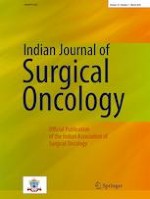Erschienen in:

26.08.2022 | Original Article
Povidone Iodine Sclerotherapy for the Treatment of Persistent Seromas after Breast Cancer Surgery
verfasst von:
Ravinder Chowrappa Sanjeeviah, Mahesh Bandimegal, Vijayraj Patil, Kanmani Govindrao Telkar, Naveen Shivanna Gowda
Erschienen in:
Indian Journal of Surgical Oncology
|
Ausgabe 1/2023
Einloggen, um Zugang zu erhalten
Abstract
Persistent seroma following breast cancer surgery causes morbidity and delays adjuvant treatment. Sclerotherapy helps in managing recalcitrant seromas. We evaluated efficacy of 10% povidone iodine sclerotherapy treatment for persistent seromas after breast cancer surgery. Persistent drainage of > 100 mL/day 15 days following surgery, and seromas that required aspiration > 100 mL/week 2 weeks after drain removal, was considered for 10% povidone sclerotherapy in a non-randomized observational study. Resolution (drain output < 20 mL/day), treatment days, recurrence, and complications were assessed as measures of efficacy. Descriptive measures of central tendency and dispersion were reported. The relationship of the seroma quantity with risk factors (age, body mass index, levels and number of axillary lymph nodes dissected, neoadjuvant chemotherapy) and efficacy was analysed. We examined the correlation using Pearson and Spearman’ signed rank, Student’s t, and Mann–Whitney U-tests, to compare the means. Of 14/312 (4.5%) patients with persistent seroma, 13 (92.8%) had complete resolution after sclerotherapy within 6.71 days (range: 6–8). AC (p = 0.04), neoadjuvant chemotherapy (NACT) (p = 0.005), and number of nodes harvested without NACT (p = 0.025) were significantly associated with the quantity of discharge, while age (p = 0.072), body mass index (p = 0.432), type of surgery (breast conservation surgery vs. modified radical mastectomy) (p = 0.28), and total number of axillary lymph nodes (p = 0.679) were not. When used in this unique innovative manner, 10% povidone iodine sclerotherapy was found to be very effective (93%), minimally invasive, and safe in our study, and therefore appears to be an ideal sclerosing agent.